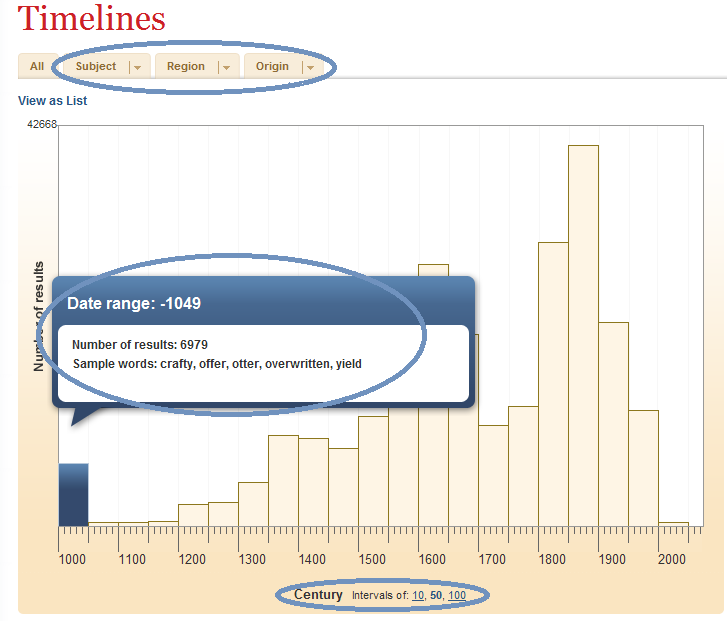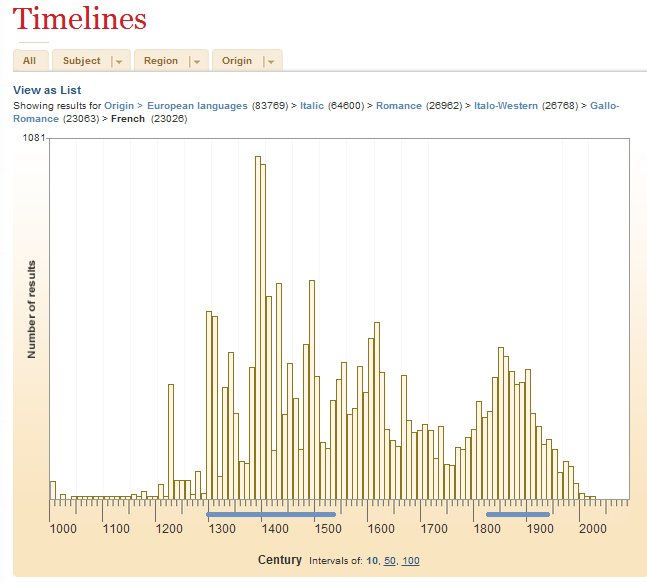The timeline feature is certainly the most notable new element of the OED online version. A timeline-link appears on the main OED page as well as in the top left corner of every list of search results. Clicking on one of these links, a graphical representation appears, illustrating the time when words (e.g. of the current search) entered the English language. Here, each bar in the diagram represents a certain period of time. The width of these intervals can be adjusted to 10, 50 or 100 years by using the interval specification below the X-axis. As usual, the height of each bar indicates the number of relevant incidences in the specific time period. In addition to this very general overview, the exact number of results and some sample words are shown when the mouse is moved across any bar, and the full set of results appears when clicking it.

Screen shot 2 Timeline
The research can be restricted and therefore specified further as it is possible to choose to work only with words of a specific subject, region or origin. In order to highlight the possibilities and advantages of such a diachronic and topic-based approach the influence of French on the English language is investigated with the help of the timeline function in what follows.
Carrying out this sample project, the first step is to restrict the search in a way that only word entries with a French origin are listed. This is done by selecting Origin in the drop-down menu. This leads to a list of several new sub-categories, based on the general differentiation of language families. For this specific search request it is necessary to restrict the place of origin repeatedly (European languages – Italic – Romance – Italio Western – Gallo-Romance – French). At the end 23026 relevant words with French origin in the English language are shown in a diagram.

Screen shot 3 Words with French origin in the English language
The diagram itself shows strongly fluctuating figures throughout the centuries. This indicates that French had a strong influence on the English language at times and was also of minor importance at others.
Looking at OE, the relatively low number of results reveals a relatively low influence of the French language during the first centuries documented (1000-1200). The few loanwords listed for this period, however, are mostly connected with travel (e.g. pilgrim ca. 1100) or with public affairs and society on a wider scale (e.g. council, duke, war ca. 1120). From 13th century onwards this influence increases abruptly from 1 incident in 1210 to 362 in the decade after. Irrespective of some slumps the number of French loanwords increases in the following decades. This general trend marks the whole 14th century. At the beginning of the 15th century the number of new French words entering the English language reaches its peak. In the decade between 1380 and 1389, 1081 new appearances are listed. Afterwards, the number of new loanwords falls steadily (15th = 4211; 16th = 3277; 17th =2830) until the graph reaches a relatively low point with only 1832 new loanwords in the 18th century. Nevertheless, the overall number of newly integrated French words remains significant enough to assume a moderate but decreasing French influence. From 1750 to 1850 another slight increase is recorded that has its peak in the decade of the 1850’s with 479 words. This second peak is significantly smaller than the first one and therefore less influential. It is striking that many new words in this time span either have negative connotations (e.g. abnormal, anticivism or antipathic) or are related to scientific innovations/discoveries (e.g. chitin, chloroform or dextrin). From 1900 onwards, the number of French loanwords decreases drastically until it nearly vanishes in the present day.
As Britain and France share a rich but also conflicting history, one possibility to explain the development of this briefly depicted history of French loanwords could be to set the figures in the diagram in relation to major historical events. Major events that immediately come to mind are the Norman invasion 1066 and the French Revolution 1798. Looking at the figures of the appropriate bars in the diagram, only a low number of French words entered the English language in these decades (e.g. 220 in 1780-89). One explanation for the lack of French words could be that foreign words are not easily accepted in other languages and that external change is often rejected by society at first. Therefore, the influence might be temporarily shifted. This hypothesis is supported by the given figures. An increase of French loanwords is shown a decade after the outbreak of the French Revolution. Nevertheless, historical events are just one explanation for language variation and change. Other explanations (e.g. ambiguity avoidance, introduction of new inventions/principles or general European language trends) might be of equal importance. In order to get a reliable interpretation of the French influence on the English language, a more detailed study would be necessary. Another idea is to investigate loanwords of different origins, regions or subjects and to analyze their influence on English in different periods.
Created with the Personal Edition of HelpNDoc: Easily create Web Help sites